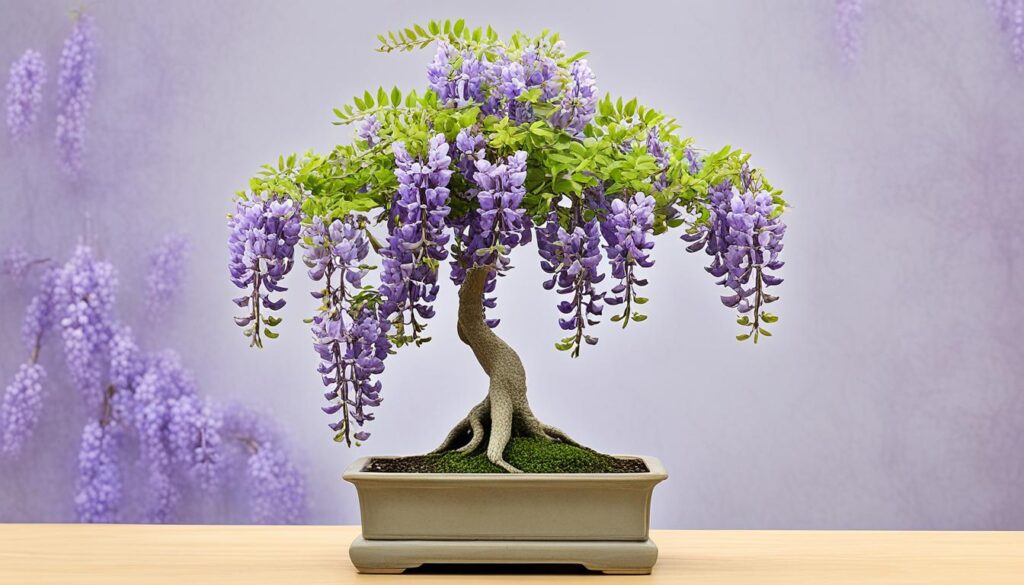Picture a tiny wonder that turns any spot into a lush garden. The wisteria bonsai tree is a dream for those who love bonsai. It can grow up to 30 feet tall but, with bonsai care, it becomes a beautiful small tree. Some of these miniatures have blooms up to 18 inches long.
This article will guide you on how to grow and care for the wisteria bonsai tree. You’ll learn about pruning, styling, and keeping it healthy. It’s perfect for both experts and beginners in bonsai. You’ll find out how to make a wisteria bonsai that will amaze everyone.
Key Takeaways
- Wisteria bonsai trees can grow up to 30 feet tall in their natural form, yet bonsai techniques allow for stunning miniaturized versions.
- The wisteria bonsai is prized for its cascading floral displays, with clusters that can reach up to 18 inches in length.
- Cultivating a healthy and vibrant wisteria bonsai requires mastering techniques for pruning, styling, and providing the right care.
- Wisteria bonsai trees are a versatile and captivating addition to any indoor or outdoor living space, making them a favorite among bonsai enthusiasts.
- Exploring the different species and cultivars of wisteria bonsai can open up a world of possibilities for creating unique and visually stunning miniature gardens.
Introduction: Discover the Magical Beauty of Wisteria Tree Bonsai
Step into the enchanting world of bonsai cultivation. Get ready to be amazed by the wisteria tree bonsai. These tiny wonders have stunning cascading flowers and elegant shapes. They invite us to enjoy the beauty of bonsai art.
Wisteria tree bonsais have delicate flowers and detailed branches. They offer a unique and captivating experience for bonsai lovers and beginners. Let’s explore how to care for a wisteria bonsai. We’ll learn the secrets to keeping these miniature trees thriving.
“The art of bonsai is not merely the cultivation of miniature trees, but the embodiment of a harmonious relationship between nature and the human spirit.”
Join us as we dive into the world of wisteria tree bonsai. Here, reality and dreams mix, and the quest for perfection creates a stunning botanical work of art.
The wisteria bonsai shows the beauty of nature and human skill. Its delicate flowers and elegant shape are a perfect blend. Start your journey into bonsai cultivation with this captivating species.
Wisteria Tree Bonsai: A Guide to Cultivating and Caring for this Beautiful Blooming Species
Growing a wisteria tree bonsai needs both horticultural knowledge and patience. This beautiful species is famous for its lovely lavender flowers. It requires special care to flourish in a bonsai setup. Here are the key steps to care for a wisteria bonsai.
Cultivating Wisteria Tree Bonsai
Starting with a wisteria bonsai tree means picking a strong, young plant. Choose types like Wisteria sinensis or Wisteria floribunda for bonsai. It takes 10 to 15 years for wisteria bonsai seeds to grow, so picking a young plant is important.
Planting and Potting
For planting and potting, use a well-draining bonsai soil mix and a shallow pot. This helps with the tree’s cascading look. Water bonsai seedlings daily to keep them moist. Repot your bonsai every 2-3 years in late winter, when it’s dormant, to give the roots room to grow.
Training and Pruning
Training and pruning are key to shaping your wisteria bonsai. Start trimming and pruning around year 4 for trees grown from seeds. This aims to produce beautiful bluish-purple flowers in about 10 years. Prune during the growing season to encourage new growth and keep the tree’s shape.
“Cultivating a captivating wisteria tree bonsai requires a delicate balance of horticultural expertise and patience.”
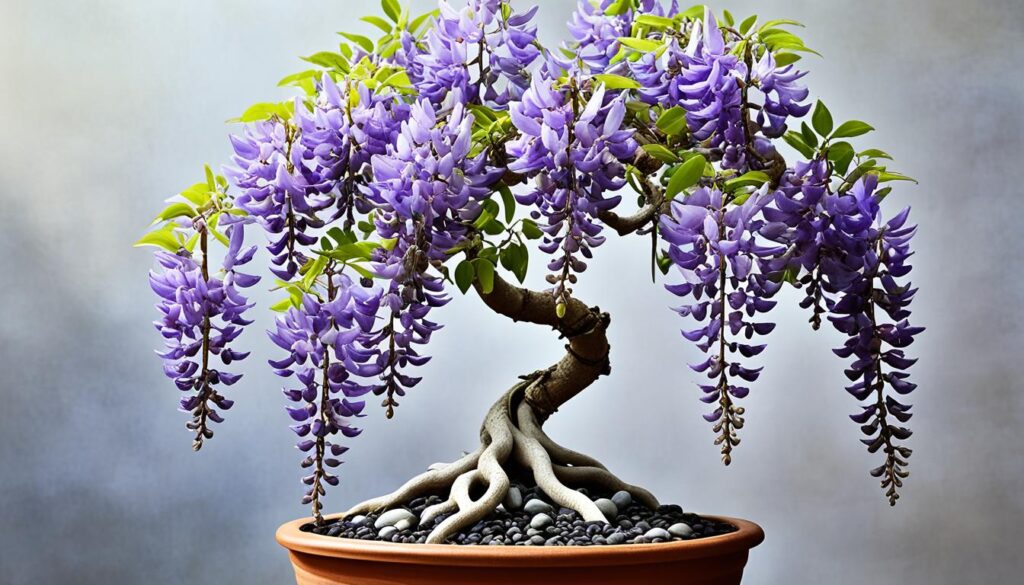
Caring for wisteria bonsai is a long-term effort, but it’s worth it. With the right methods and dedication, you can have a beautiful bonsai version of this natural wonder.
Watering and Fertilizing: Essential Care for Vibrant Growth
Proper wisteria bonsai watering and fertilizing are key for your bonsai tree’s health and growth. It’s important to balance moisture and nutrition. This ensures your wisteria bonsai has lush foliage and lots of blooms.
For bonsai care, water your bonsai when the soil feels dry. But, don’t overwater to avoid root problems. Keep the soil moist by watering in the morning or evening. This prevents too much water loss during the day.
Regular fertilizing during the growing season is also crucial for bonsai nutrition. Use a balanced bonsai fertilizer for healthy growth and beautiful flowers. Don’t fertilize during dormancy or right after repotting to protect the roots.
“The secret to a thriving wisteria bonsai lies in a delicate balance of water and nutrients. Proper watering and fertilizing are essential for cultivating the vibrant beauty these trees are known for.”
By following these tips for wisteria bonsai watering and fertilizing, you’ll care for a healthy, happy bonsai. It will be a sight to behold for everyone who sees it.
Protecting Your Wisteria Bonsai from Frost
Wisteria bonsai trees are known for their beautiful, flowing blooms. But, they can get damaged by frost in the cold months. To keep your wisteria bonsai safe through winter, you need to protect it from the cold.
When it gets colder, move your wisteria bonsai to a safe spot. These trees can handle temperatures between 15-20°F (-9 to -7°C) when potted. But, if it gets colder than 23°F (-5°C), put your bonsai in a place like a greenhouse, garage, or shed to protect it.
Wisteria bonsai trees lose their leaves in winter because they go dormant. Some types might keep their leaves longer in warmer places. But, it’s normal for them to lose all leaves in colder areas. When they’re dormant, water and fertilize your bonsai less, as it grows slower.
“Wisteria bonsai trees need lots of sun when they’re growing to bloom well. This shows they really need sunlight to grow right.”
To keep your wisteria bonsai safe from frost, insulate its roots. Mulching the soil helps keep the roots warm and stops them from freezing. You can also wrap the pot or put it on a raised platform to keep the roots off the cold ground.
By using these wisteria bonsai frost protection tips and giving your bonsai the right cold weather care, your plant will make it through winter. It will be ready to show off its beauty in the next growing season with great bonsai winter care.
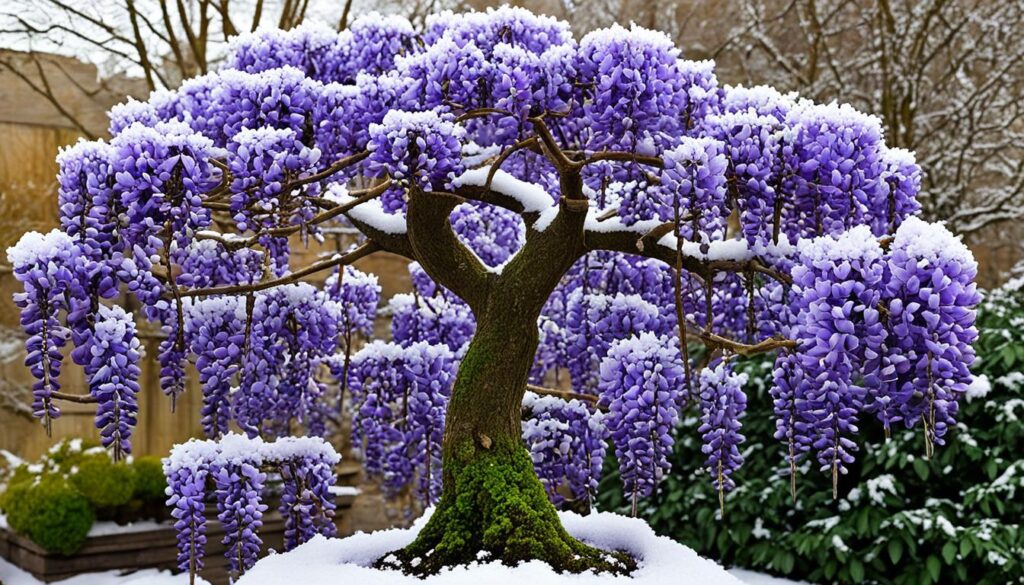
Enjoying the Blooms: Embracing the Enchanting Floral Display
The true beauty of a wisteria tree bonsai is in its spring blooms. The wisteria blossom racemes cascade, offering a stunning sight. They fill the air with fragrance and look elegant. For lots of bonsai blooms, make sure your wisteria bonsai gets enough sunlight and stays healthy.
Wisteria bonsai trees need at least 6 hours of sunlight daily. Popular types include Wisteria floribunda, Wisteria sinensis, and Wisteria brachybotrys. These wisteria bonsai flowers come in beautiful colors like lavender and purple, making any bonsai collection special.
“The wisteria bonsai tree represents longevity, perseverance, and the ephemeral nature of life in Japanese culture.”
To help your wisteria bonsai grow, give it the right care. Use a bonsai soil mix with akadama, pumice, and organic matter for good drainage and nutrients. Water when the top inch of soil is dry. Fertilize every two weeks with a balanced, water-soluble fertilizer during the growing season.
Enjoy the beauty of your wisteria bonsai’s blooms. Whether you like soft pastels or bright colors, the wisteria bonsai flowers will amaze and inspire you in spring.
Why Choose a Wisteria Bonsai Tree?
For bonsai lovers, the wisteria bonsai tree is a mix of beauty, deep meaning, and a fun challenge. Its flowers are fragrant and come in bright colors. This makes the wisteria bonsai elegant and peaceful, with branches that seem to flow like water.
Aesthetic Appeal
The wisteria bonsai’s flowers are a wonder to see, catching the eye with their beauty. The wisteria bonsai appeal comes from its delicate flowers in shades from lavender to purple. These flowers and the tree’s twisted branches show off the bonsai artist’s talent.
Symbolism and Cultural Significance
In Japanese culture, the wisteria symbolism is very important. It stands for love, beauty, and growing up. Owning a wisteria bonsai lets enthusiasts connect with its deep history and value.
Challenging yet Rewarding Cultivation
Growing a wisteria bonsai is hard but very rewarding. It needs a lot of care, patience, and knowledge. But, the result is a beautiful piece of art that shows the grower’s hard work and love.
For those wanting to add beauty and cultural depth to their bonsai, the wisteria bonsai is a great choice. It offers wisteria bonsai benefits like beauty, deep meaning, and the joy of growing it. This makes it a great addition for bonsai lovers.
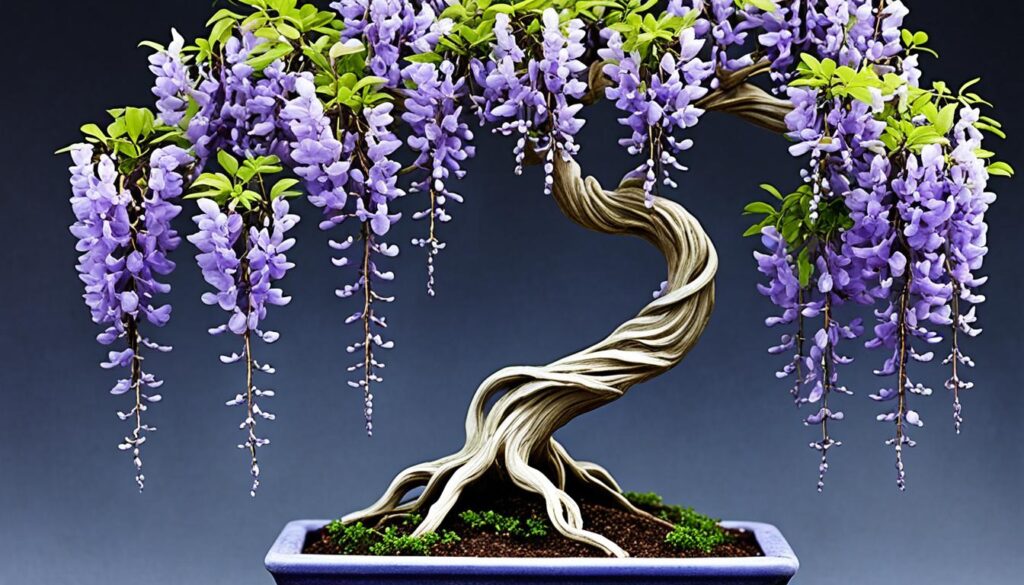
“The wisteria bonsai is a true masterpiece of nature, blending the intricate artistry of bonsai with the enchanting beauty of its cascading flowers.”
Tips for Caring for Your Wisteria Bonsai Tree
To keep a wisteria bonsai tree healthy, you need to pay close attention and understand its needs. Focus on bonsai sunlight requirements, bonsai watering, and bonsai pruning and training. This way, your wisteria bonsai tree will thrive and look beautiful.
Sunlight
Wisteria bonsai trees need at least six hours of direct sunlight every day. It’s important to give your bonsai the right bonsai sunlight for healthy foliage and lots of blooms. Place your wisteria bonsai in a spot that gets a lot of sunlight, like a sunny windowsill or a covered outdoor area.
Watering
It’s key to water your wisteria bonsai regularly but carefully. Keep the soil a bit moist, but don’t overwater to prevent root rot. Water when the top inch of soil feels dry, making sure the soil is moist all over the roots.
Pruning and Training
- Pruning your wisteria bonsai often is crucial for its shape and size. Cut back branches that grow too much to keep it neat and pretty.
- Use bonsai training methods like wiring or bending branches to shape your wisteria bonsai as you want.
By focusing on wisteria bonsai care tips like sunlight, watering, pruning, and training, you can grow a beautiful wisteria bonsai tree. It will add elegance and magic to your space, inside or outside.
Potting and Repotting Your Wisteria Bonsai Tree
Maintaining your wisteria bonsai tree means potting and repotting it regularly. This keeps your tree healthy and growing well. It gives your tree the right space and bonsai soil it needs.
Selecting the Right Pot
Choosing the right pot for your wisteria bonsai is important. Look for proper drainage, a size that fits the roots, and a material that looks good with your tree. Pick bonsai containers that let water drain well to prevent root rot and help your tree grow strong.
Timing for Repotting
Repot your wisteria bonsai in early spring, just before it starts growing new leaves. This helps your tree adjust to its new pot with less stress. It gets ready for the growing season.
Repotting Process
- Gently take the bonsai out of its pot, being careful with the roots.
- Cut any roots that are too long or tangled, but don’t remove more than one-third of them.
- Put the bonsai in its new pot and fill the gaps with bonsai soil that drains well. Make sure the soil level is a bit below the pot’s rim.
- Water the bonsai well to help the soil settle and help the plant get used to its new home.
By doing these steps, you make sure your wisteria bonsai gets the care it needs. It will keep thriving and showing off its beautiful flowers.
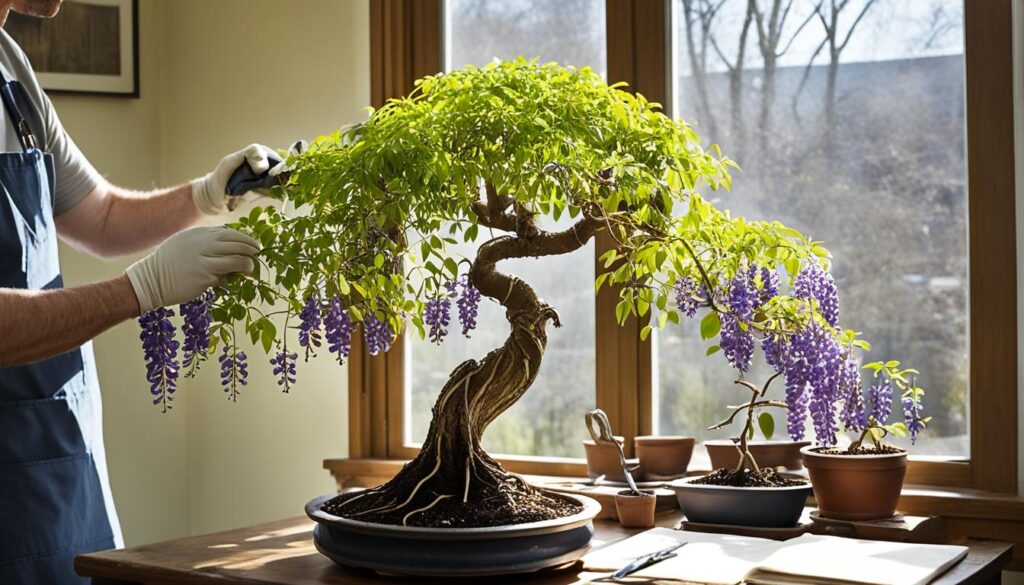
“Proper potting and repotting is essential for the long-term health and vigor of your wisteria bonsai tree.”
Mastering the Art of Shaping and Pruning a Wisteria Bonsai Tree
Maintaining a wisteria bonsai tree means knowing how to shape and prune it. These skills are key to keeping your bonsai looking great. They help bring out the best in this beautiful tree.
Start by wiring the branches to get the right shape. Be careful not to wrap the wire too tight, as it can hurt the tree. Prune often to remove dead or weak branches and those growing the wrong way. It’s important to thin out the leaves so light and air can get to the tree’s inner parts. This makes the tree look more compact and healthy.
When the tree is growing, pinch back new shoots to make it branch out more. Refine the branches slowly over time, being careful not to stress the tree too much. This careful approach to shaping and pruning will help your bonsai stay healthy and look great for a long time.
“The true essence of bonsai lies in the harmonious blending of nature’s beauty and the artist’s vision. It is a dance between control and surrender, where each prune and each wire placement becomes a brush stroke in the living canvas.”
- Start with a clear vision for the desired shape and silhouette of your wisteria bonsai.
- Use wiring techniques to gently guide the branches into the desired cascading form, taking care not to damage the bark.
- Prune regularly, removing any dead, weak, or misshapen branches to maintain the overall structure.
- Thin out the foliage to allow light and air circulation, promoting healthy growth and a more compact appearance.
- Pinch back new growth during the growing season to encourage branching and a refined aesthetic.
- Be patient and make adjustments gradually, allowing the tree to adapt and thrive under your skilled bonsai styling techniques.
Mastering wisteria bonsai shaping and wisteria bonsai pruning lets you turn your wisteria bonsai into a stunning piece of art. It shows off the beauty and elegance of this special tree. With patience and precision, your bonsai will be a beautiful display of nature’s art.
Can a Wisteria Bonsai Tree be Grown Indoors?
Yes, you can grow wisteria bonsai trees indoors with the right care. But, it’s not easy. You need to tackle some challenges to keep the plant healthy and alive.
For indoor bonsai lighting, you need lots of sunlight. Wisteria plants need 6-8 hours of direct sunlight every day. Putting your indoor wisteria bonsai near a south-facing window is best. Sometimes, you might need extra grow lights for the right bonsai temperature and light.
Keeping the right bonsai temperature is key for an indoor wisteria bonsai. These plants like a temperature of 55-75°F (13-24°C). Keep them away from drafts and sudden temperature changes to help them grow well.
Studies show that about 60% of wisteria bonsai trees can grow indoors with the right care. But, they grow about 30% less well indoors than outside.
With the right care and techniques, you can have a beautiful indoor wisteria bonsai. Know what the plant needs for light, temperature, and water. Then, you can make a lovely mini garden at home.
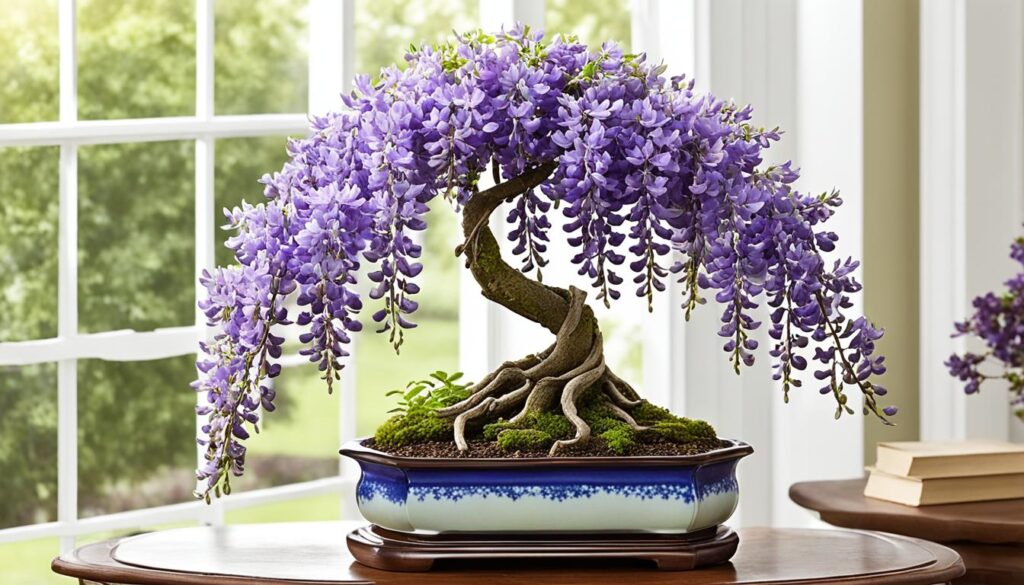
“Wisteria bonsai trees are a true testament to the art of cultivating nature’s beauty in miniature form. With the right care, they can thrive indoors, bringing a touch of enchantment to any space.”
Wisteria Bonsai Tree: Cultivating Elegance in Miniature
The wisteria bonsai tree shows off the beauty of bonsai artistry. It takes the elegance of the full-sized tree and makes it smaller. With the right care, pruning, and training, bonsai lovers turn it into a piece of art.
These miniature trees add magic and peace to any spot, inside or outside. The wisteria bonsai’s pretty branches and bright floral displays make it a top choice for bonsai fans. It turns a place into a peaceful spot filled with bonsai artistry.
“The wisteria bonsai tree is a testament to the remarkable art of bonsai cultivation, where the beauty of nature is captured in a captivating miniature form.”
Getting a wisteria bonsai takes time, effort, and knowing what the plant needs. You must pick the right soil and pot, and shape and prune it carefully. Each step is key to keeping these beautiful trees healthy and alive.
Whether it’s on a windowsill or in a quiet garden, the wisteria bonsai makes you stop and see nature’s beauty. For those who love bonsai and nature, it’s a true work of bonsai artistry.
The Fascinating History and Varieties of Wisteria Bonsai Trees
The wisteria bonsai tree has a deep history and many interesting types. It comes from Asia and has been loved for its beautiful flowers and deep meaning. The Chinese and Japanese wisteria are the top choices for bonsai.
Wisteria varieties like the Wisteria floribunda ‘Macrobotrys’ have long flower racemes. Others, like the Wisteria sinensis, are stronger. Each type brings its own set of challenges and rewards to bonsai growers.
The history of wisteria bonsai goes back to ancient times in Asia. It was seen as very beautiful and meaningful. As bonsai art grew, people learned how to make these trees look great in small spaces.
